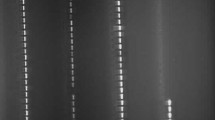Abstract
Various populations have contributed to the present-day gene pool in oriental Mediterranean (Aegean Sea) and are well documented for ancient history. The primary objective of the study is to report on the analysis of the paternal component of the variation (Y chromosome haplotypes) in contemporary populations in Greece, Crete, Turkey and Cyprus. A total of 245 males who hailed from five different locations in Turkey, Greece, and the islands of Crete and Cyprus were analyzed for Y-chromosome-specific haplotypes based on p49a,f TaqI polymorphism. The main haplotype observed (21.2%) in the Greek–Turkish area is haplotype VII. The second haplotype in terms of frequency (13.5%) is haplotype VIII, which is characteristic of Semitic populations. The third (11.4%), fourth (6.9%) and fifth (5.7%) haplotypes in frequency are haplotype XI (a typical eastern European haplotype), haplotype V (the North African haplotype) and haplotype XV (the Western European haplotype), respectively. The distribution of haplotype VII is significantly heterogeneous genetically among the five localities studied, with a peak of frequency (43.8%) in Crete. It is proposed that haplotype VII reflects the ancient Minoan civilization. Haplotype VII frequencies actually known are mapped in countries surrounding the Mediterranean Sea.



Similar content being viewed by others
References
Gautreau C, Rahuel C, Cartron JP, Lucotte G (1983) Comparison of two methods of high-molecular-weight DNA isolation form human leucocytes. Anal Biochem 134:320–324
Hill EW, Jobling MA, Bradley DG (2000) Y-chromosome variation and Irish origins. Nature 2004:351–352
Jovelin F, Berthaud S, Lucotte G (2003) Molecular basis of the TaqI p49a,f polymorphism in the DYS1 locus containing DAZ genes. Mol Hum Reprod 9:509–516
Lucotte G, David F (1992) Y-chromosome specific haplotypes of Jews detected by probes 49f and 49a. Hum Biol 64:757–761
Lucotte G, Hazout S (1996) Y-chromosome DNA haplotypes in Basques. J Mol Evol 42:472–475
Lucotte G, Loirat F (1999) Y-chromosome DNA haplotype 15 in Europe. Hum Biol 71:431–437
Lucotte G, Mercier G (2003) Y-chromosome DNA haplotypes in Egypt. Am J Phys Anthropol 121:63–66
Lucotte G, Mercier G (2003) Y-chromosome DNA haplotypes in Jews: comparison to Lebanese and Palestinians. Genet Test 7:67–71
Lucotte G, Ngo KY (1985) P49f, a highly polymorphic probe that detects TaqI RFLPs on the human chromosome. Nucleic Acids Res 13:8285
Lucotte G, David F, Mariotti M (1991) Nucleotide sequence of p49a, a genomic Y-specific probe with potential utilization in sex determination. Mol Cell Probes 5:359–363
Lucotte G, Smets P, Ruffié J (1993) Y-chromosome specific haplotype diversity in Ashkenazic and Sephardic Jews. Hum Biol 65:835–840
Lucotte G, Grard N, Krishnamoorthy R et al (1994) Reduced variability in Y-chromosome specific haplotypes for some Central African populations. Hum Biol 66:519–526
Lucotte G, David F, Berriche S (1996) Haplotype VIII of the Y chromosome is the ancestral haplotype in Jews. Hum Biol 68:467–471
Lucotte G, Aouizérate A, Berriche S (2000) Y-chromosome DNA haplotypes in North-African populations. Hum Biol 72:473–480
Lucotte G, Pinna A, Mercier G (2003) Haplotypes du chromosome Y en Corse. C R Biol 235:191–196 (in French)
Lucotte G, Mercier G, Diéterlen F (2003) Y-chromosome DNA haplotype XI is Eastern Europe. Hum Biol 75:405–410
Malaspina P, Tsopanomichalou M, Duman T et al (2001) A multistep process for the dispersal of a Y chromosomal lineage in the Mediterranean area. Ann Hum Genet 65:339–349
Ngo KY, Vergnaud G, Johnsson C, Lucotte G, Weissenbach J (1986) A DNA probe detecting multiple haplotypes on the human Y chromosome. Am J Hum Genet 38:407–418
Passarino G, Semino O, Magri C et al (2001) The 49a,f haplotype 11 is a new marker of the EU19 lineage that traces migrations from Northern regions of the Black Sea. Hum Immunol 62:922–932
Persichetti F, Blasi P, Hammer M et al (1992) Disequilibrium of multiple DNA markers on the human Y chromosome. Ann Hum Genet 56:303–310
Quack B, Guérin P, Ruffié J, Lucotte G (1988) Mapping of probe p49f to the proximal part of the human Y chromosome long arm. Cytogenet Cell Genet 47:232
Santachiara-Benerecetti AS, Semino O, Passarino G et al (1993) The common Near-Eastern origin of Ashkenazi and Sephardi Jews supported by Y-chromosome similarity. Ann Hum Genet 57:55–64
Saxena R, Brown L, Hawkins T et al (1996) The DAZ gene cluster on the human Y chromosome arose from an autosomal gene that transposed repeatedly amplified and pruned. Nat Genet 14:292–299
Saxena R, de Vries JWA, Repping S et al (2000) Four DAZ genes in two clusters found in the AZFc region of the human Y chromosome. Genomics 67:256–267
Semino O, Passarino G, Brega A, Fellous M, Santachiara-Benerecetti AS (1996) A view of the neolithic demic diffusion in Europe through two Y-chromosome specific markers. Am J Hum Genet 59:964–968
Semino O, Passarino G, Quintana-Murci L et al (2000) MtDNA and Y chromosome polymorphisms in Hungary. Inferences from the paleolithic, neolithic and Uralic influences on the modern Hungarian gene pool. Eur J Hum Genet 8:33–6346
Semino O, Passarino G, Oefner PJ et al (2000) The genetic legacy of Paleolithic Homo sapiens sapiens in extant Europeans: a Y chromosome perspective. Science 290:1155–1159
The Y-Chromosome Consortium (2002) A nomenclature system for the tree of human Y-chromosomal binary haplogroups. Genome Res 12:339–348
Acknowledgements
We thank A. Aouizérate for genomic DNA extraction, and S. Berriche and F. David for hybridization experiments. We gratefully acknowledge G. Mercier for helpful statistical treatment of the data. This work is included as our special contribution to the “Demic Diffusion Program from the Levant” in European populations.
Author information
Authors and Affiliations
Corresponding author
Rights and permissions
About this article
Cite this article
Lucotte, G., Yanakakis, N. & Diéterlen, F. Y-Chromosome Haplotypes in the Greek–Turkish Area. Intl Jnl Anthropology 21, 123–129 (2006). https://doi.org/10.1007/s11599-006-9020-3
Received:
Accepted:
Published:
Issue Date:
DOI: https://doi.org/10.1007/s11599-006-9020-3



